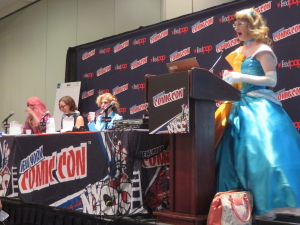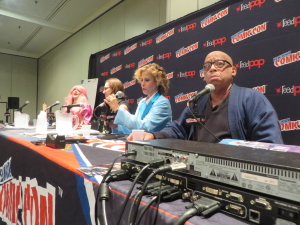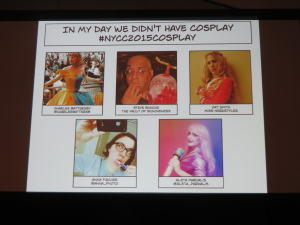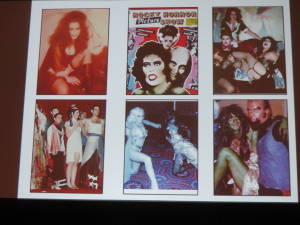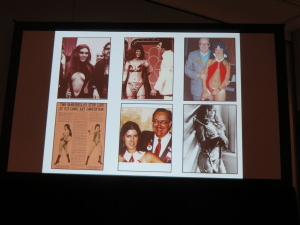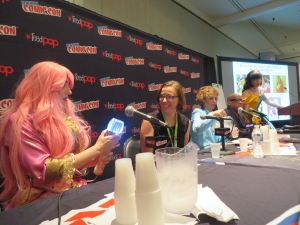“IN MY DAY, WE DIDN’T HAVE COSPLAYâ€
PANEL AT NYCC 2015
AMBER LOVE 02-NOV-2015 Here’s the audio of the COSPLAY panel at New York Comic Con. Obviously, talking about cosplay is something that required a fair amount of visuals so it may feel a little lacking without video. I hope you still enjoy the discussions. You can sponsor the show and the site for as little as $1/week at Patreon.com/AmberUnmasked.
NOTE: As tends to happen at live recordings, there were men in the front row (I was right behind them) who, for whatever reason, kept talking. I eventually told them to stop. If you aren’t interested and need to rest, fine, but don’t talk through a panel!
Download on iTunes, Stitcher or listen here.
PANELISTS:
Moderator – Charles Battersby, a past Vodka O’Clock guest and truly the best moderator I’ve ever seen. He keeps people moving along and on topic; no one was interrupted; the visuals were great.
Steve Bunche – former DC and Marvel editor who has been attending comic cons in New York since the dawn of existence. He’s encyclopedic about comics, their creators, and the lore/mythology the stories are based on. He’s a personal close friend of mine so I know his appreciation for cosplay and fandom especially well-crafted obscure sci-fi characters.
Cat Smith – cosplayer
Anna Fischer – photographer
Aleta Pardalis – cosplayer
Of those last three, photographer Anna Fischer is the only person I had a vague knowledge about because I’ve seen the work she’s done with lots of my cosplay acquaintances.
THE PANEL ITSELF:
The title of the panel was clever if you knew what they were going for. “In My Day We Didn’t Have Cosplay†was not meant to mean there weren’t costumed fans at conventions. There always have been, but the Japanese/kotaku word “cosplay†came into use fairly recent in American fandom.
The long history of this tradition was covered quite well by the panel. They had some photographs and old magazine pages with fans in costume going back to the 1930s, but mostly the 70s. The 70s, they explained, brought out obsessive fans which began with THE ROCKY HORROR PICTURE SHOW and STAR TREK.
Anna Fischer explained the generational issue where fans/creators who have been in the convention scene a long time aren’t welcoming to change and newer fans especially if they were fans of non-book media like TV and movies.
COMPETITIVE NATURE OF COSPLAY:
The best part of the panel was The Tale of Two Vampirellas which got into the story from the early 70s where an adult Vampirella fan began dressing up as the character, but because of her work as a stripper with the stage name Destiny, some people weren’t welcoming to her (like the fake geek girl wars we have today). Her name was Angelique Trouvere. According to my post-con research, Angelique was great about collecting historical information about the Vampi fandom. She wasn’t the first person to dress up as Vampi, but she was the first to be “cos-famous†for it.
But in 1973, an underage fan named Heidi Saha had parents connected to the science fiction publishing industry and who were trying to launch Heidi’s modeling career and felt the best way to do that was to get Heidi be the official Vampirella.
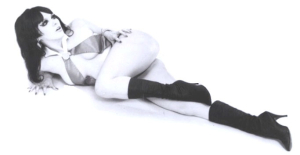
Angelique and Heidi competed against each other in contests, but Heidi, who was only 14 at the time, was taken on tour as Vampirella. The creator of Vampirella, Forrest J. Ackerman was so smitten by Heidi that he created a one-shot magazine issue all about her, Illustrated History of Heidi Saha. Heidi also had the chance to appear as Sheena, Queen of the Jungle. She was contracted for two years to be a professional costumed model from ages 14-16. Heidi’s fame even sparked the first cosplay porn parody which was when an adult who looked young enough and looked like Heidi enough to portray her, modeled for a still shot that accompanied a poem and distributed in underground through mimeograph copies.
“They tried to turn her [Heidi] into the next pinup superstar. You can look at the back of their magazine and there were ads for Heidi Saha poster and Heidi Saha fan magazine. Meanwhile there were those of us everywhere who were like, ‘who the hell is Heidi Saha?’ first of all. Unless you were in on the convention cosplay circuit, you had no idea who she was. Literally, she did not exist outside of that very specific sphere no matter how hard they tried to push her. And then once all of this came out she was only 15, it became super creepy.†~ Steve Bunche
Angelique got to pose for Neal Adams and appear in Vampirella #44. She seems to be the source of successfully bridging adult entertainment and cosplay in the sense that people often think women in the adult business aren’t real fans. Angelique became enamored with the character when someone in the audience was reading a Vampirella comic instead of watching her dance; she wanted to know what was so fascinating and from there, her fandom began.
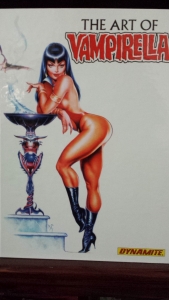
1969 was actually the first Vampirella cosplay (Kathy Bushman); and quickly after, in 1970, Marvel wanted to capitalize on the trend and hired an adult/porn model to cosplay as Spiderwoman which was the first known case of fans complaining about a woman in a costume being a fake geek because they hired a model not a fan.
Then in the early 1990s, the comic book publishers didn’t like fans dressing up as their characters in this unofficial cosplay capacity. Charles Battersby spoke about when DC (he doesn’t even name the publisher when telling this story) asked him to leave a convention because was crossplaying as Catwoman.
RESOURCES:
Smith and Pardalis did discuss some methods to their crafting and what materials they use. GlowForge 3D printing was mentioning and as soon as it’s affordable, I’m sure will revolutionize cosplay; their basic model is still $2400.

